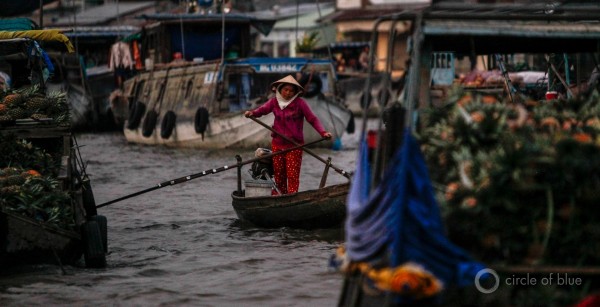River flows are historically low in Vietnam.

A small tributary canal of the Mekong, north of Can Tho, Vietnam, where salinification is damaging rice fields and fruit orchards. © J Carl Ganter / CircleofBlue.org
By Brett Walton, Circle of Blue — March 3, 2016
The worst drought in decades in Southeast Asia has weakened one of its great rivers to the point where it is losing a battle with the sea.
Water flows in the lower Mekong River in Vietnam are so feeble that salt water from the South China Sea is pushing through the delta, up to 40 kilometers (25 miles) inland along the river’s main stem and more than 70 kilometers (43 miles) inland on tributaries. The salt, damaging to crops, is a disaster for rice farmers in the delta, which accounts for half of Vietnam’s rice production.
Not only a short-term emergency, the drought is also magnifying longstanding fault lines in the six-country basin. Even before the strong El Nino of the last six months turned off the rain spigot, the water resources of the Mekong River were under immense pressure. A cascade of major dams are planned or under construction on both the river’s main stem and its tributaries. In the eyes of governments and developers, the dams are hydropower cash registers and a cure for daily blackouts. To environmental and civil society groups, however, the dams are a scourge: uprooting communities, flooding forests, threatening one of the world’s great warehouses of biodiversity, and endangering the livelihoods of tens of millions of people who catch fish for food.
Persistent pressure from the latter groups is forcing developers to spend more money to alter dam designs. The question now is whether the drought will lead to additional changes.
Salted Fields
The Mekong begins in China’s Qinghai province and flows 4,900 kilometers (3,045 miles) through Myanmar, Laos, Thailand, and Cambodia before fanning into a broad delta in Vietnam. River flows in the delta today are the lowest in decades because of a below-average rainy season.

Vietnam Can Tho Mekong River © J. Carl Ganter / Circleofblue.org
The effects are showing. The government of Long An, a delta province in Vietnam, declared a disaster because rice crops are destroyed. By some estimates nearly 1 million hectares (2.4 million acres) in the delta, half its arable land, have been damaged by salt. Vietnam’s agriculture minister, at a February conference on emergency responses to saltwater intrusion, urged farmers to pay attention to water shortages and salt levels when making planting decisions. The salt surge in the delta is expected to last through early May, according to the Ministry of Agriculture and Rural Development.
Water shortages are a problem higher in the basin too. Local newspapers are reporting that Thailand has begun diverting water from the Mekong for irrigation in its northeastern provinces, a move that irked Vietnam and was made without notifying the Mekong River Commission, a regional forum for water research and discussion of water management.
Not sending notification of a dry season diversion is a violation of the commission’s procedures. The commission would not comment on the matter.
“Although we are aware of a few news reports on this case, it is not appropriate for the MRC Secretariat to speculate on the reports,” according to a statement that the commission sent to Circle of Blue.
A New Water Cycle
All river systems have a heartbeat, an internal rhythm determined by rain, snow, and heat. The Mekong’s pulse is bigger than most. More than 80 percent of the river’s flow comes between June and November, the flood season. In these months the Mekong vaults over its banks, pools in the flood plain, reconnects spawning habitat, and restocks the delta with sediment. The big natural fluctuation is essential for the basin’s ecology.
The dry season is when pressure builds, especially in the dam-building age. There is less water in the river for hydropower generation at a time when electricity is in highest demand because of the heat. There is less water to help fish navigate around the concrete walls. Dams can increase dry season flows, but the tradeoff is a disruption of the annual flood, which is vital for sediment flows and fish habitat.
“Everything comes to a head in the dry season,” Tom Wild told Circle of Blue. Wild is a postdoctoral fellow at Cornell University who is working with the Cambodia government on designing dams that are less environmentally damaging.
According to Richard Cronin, director of the Southeast Asia program at the Stimson Center in Washington, D.C., the drought is a “sleeper element” in the dams debate.
“The drought has imposed a lot of stress among the countries,” Cronin told Circle of Blue. “It’s why Vietnam is so opposed to the dams.”
If Cambodia and Laos build the full suite of mainstem dams that they have proposed — nine in Laos and two in Cambodia — “it’s curtains for the delta,” Cronin claimed. Other research shows that even the tributary dams – there are 78 on the drawing board — will be catastrophic for the world’s largest freshwater fishery if all are built.
Yet changes are afoot. Cronin sees a new narrative developing for hydropower in the Mekong. Dams face increasing political and financial risks that challenge their viability. Costs are going up, climate change is altering water flows, and energy efficiency programs could cut electricity demand equal to what a dam would produce.
The Cornell team is also making headway. Governments and developers, no longer acting unilaterally, are at least listening to their proposals.
“We’ve been successful to the point where we’re talking to the people who are making decisions,” Daniel Peter Loucks of Cornell told Circle of Blue. “That’s not a trivial point.”
At the end of the system, the delta is where the basin’s vulnerabilities are most exposed. Dams will trap sediment needed to rebuild land, just as the oceans are rising faster than they have in the last 28 centuries. Tropical storms, growing stronger with more ocean heat, will be more damaging without coastal buffers. Drought and salt are the problems today, but floods are sure to return.
Brett writes about agriculture, energy, infrastructure, and the politics and economics of water in the United States. He also writes the Federal Water Tap, Circle of Blue’s weekly digest of U.S. government water news. He is the winner of two Society of Environmental Journalists reporting awards, one of the top honors in American environmental journalism: first place for explanatory reporting for a series on septic system pollution in the United States(2016) and third place for beat reporting in a small market (2014). He received the Sierra Club’s Distinguished Service Award in 2018. Brett lives in Seattle, where he hikes the mountains and bakes pies. Contact Brett Walton



